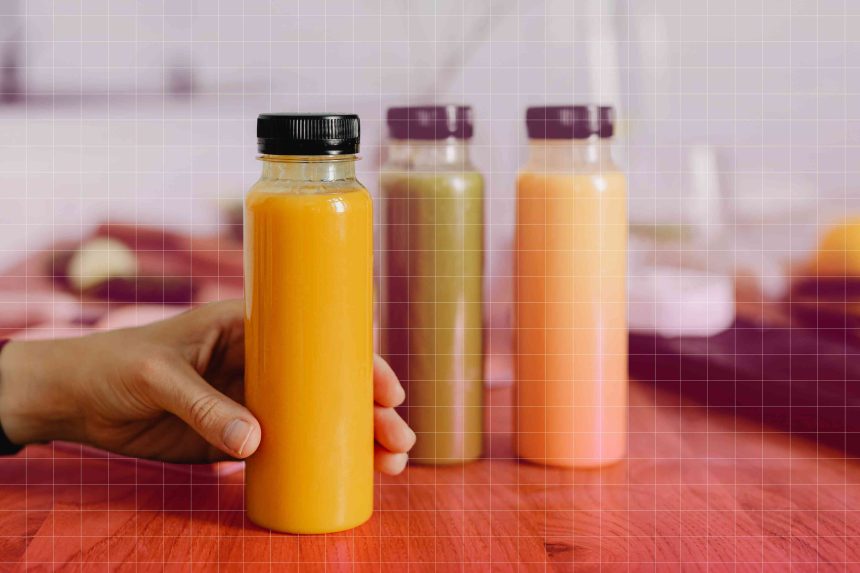We all know we need to eat fruits and vegetables, but many of us don’t get enough of them. While juicing your produce might seem like a quick fix, depending on juice also has its drawbacks.
Though juice provides antioxidants, vitamins and minerals, it lacks the fiber that whole fruits and vegetables provide—and fiber is linked with numerous benefits. It helps keep our blood vessels—and intestines—cleaned out. It helps stabilize blood sugar, and it’s a food source for beneficial gut bacteria. Eating enough fiber is even associated with a lower risk of heart disease.
Since there is no fiber in juice to slow its digestion, it can quickly spike blood sugar. This might be a good thing if you have diabetes and your blood sugar is dangerously low. But when you imbibe juice on the regular, it can send your blood sugar soaring—and then crashing. And so the cycle goes.
Then there are juice cleanses. These short-term “remedies” make promises of a healthier gut, better digestion, glowing skin and more energy, due in part to allegedly clearing toxins from the body. Some of them also claim to improve the gut microbiome. But there is previous and current evidence that suggests the opposite—that the microbiome can be negatively affected by juice cleanses. To investigate this idea further, researchers from Northwestern University conducted a small study and published their results in Nutrients in January 2025. Here’s what they found.
How Was This Study Conducted?
Researchers recruited study participants from the Northwestern University student body. After sifting through 143 applicants, 14 met the study criteria—seven women and seven men between the ages of 18 and 35 with BMIs that researchers considered in the healthy range (between 18.5 and 30 kg/m2).
Participants were then randomly split into one of three different diet intervention groups, with interventions lasting three days. One group was assigned a typical juice fast totaling 800 to 900 calories per day—for three days, they could ingest only cold-pressed juice, which was provided for them. The second group ate their regular diet, but they were also provided with optional cold-pressed juice with no calorie restriction. The third group was provided with an 800- to 900-calorie plant-based whole-food diet but consumed no juice.
Prior to beginning the three intervention days, all participants were required to consume a three-day elimination diet consisting of organic fresh fruits, vegetables, gluten-free whole grains, eggs and eight glasses of water a day—a typical procedure employed by many juice cleanses. They were also advised to avoid or eliminate alcohol, caffeine, sugar, processed foods, dairy, red meat and gluten. After the three-day elimination diet, participants began their assigned intervention diets.
Because researchers were examining participants’ oral and intestinal microbiomes, stool, saliva and cheek swab samples were analyzed at several points: baseline, after the elimination diet, immediately following the diet intervention, and again 14 days after the intervention.
What Did This Study Find?
Researchers were aiming to improve their understanding of the impact of juicing on the gut and oral microbiomes by comparing three days of juicing to a juice-plus-food diet and a plant-based, whole-foods diet that included no juice. They found that the juice cleanse increased the number of bacteria in the mouth that help digest simple sugars and are associated with inflammation and less-healthy microbiomes. The juice-plus-food group saw some of the same changes to their oral microbiomes but to a lesser degree.
It’s important to note that in those three days, only the oral microbiomes exhibited these changes. The gut microbiomes in all three groups saw very little change. This, say study authors, reflects how quickly the oral microbiome can change.
With that said, they also admit that the changes were small, which may be due to the small study sample—14 individuals—and the short study period—three days of intervention diets—and note that longer interventions would be helpful to establish more robust findings.
How Does This Apply to Real Life?
According to these researchers, 2024 reports suggest that 26% of consumers have tried a juice cleanse or detox program in the hopes of detoxification, weight loss and improved digestion—and they continue to grow in popularity. While the changes seen in this study were small, they still highlight how quickly changes in the oral microbiome can happen, depending on what we’re eating and drinking. Researchers note that while this study was short and small, microbiome changes may show a cumulative negative effect in people who do longer juice cleanses or frequent juice cleanses.
Interestingly, following the elimination diet, participants’ microbiomes showed positive changes, increasing in beneficial bacteria—likely, say the study authors, due to its higher fiber content.
So what does this all mean for you? In a nutshell, keep on aiming for a balanced diet that includes a variety of whole foods. This means eating whole fruits and vegetables, legumes, whole grains, nuts, seeds, lean proteins, fermented dairy and healthy fats. And stay well-hydrated by drinking plenty of water.
But what about juice? Juice also fits into a healthy diet—just don’t make it your primary form of produce. And make sure it’s 100% juice, not a juice beverage or juice cocktail. Those drinks can vary in how much actual juice they contain, and they tend to include lots of added sugar.
If you want the flavor of juice but with fiber, whip up a smoothie. You can pack a smoothie with whole produce, plus add protein and healthy fat to it, which means you not only get the benefit of the fiber but the combination of fiber, protein and fat will help keep you full and satisfied—and help stabilize your blood sugar. Buh-bye hangry feeling!
Because fermented foods are a dependable source of probiotics for your gut microbiome, including plain Greek-style yogurt or kefir in your smoothie is a great way to boost the protein content in your smoothie and protect your gut. Plus, the fiber in the fruits and veggies you add to your smoothie helps those probiotics grow and flourish. Win-win!
We’d be remiss if we didn’t also mention that 900 calories or less per day—the amount of calories two of the study groups took in—is too low to adequately get enough nutrients for good health—not to mention to support optimal energy levels. Frequently engaging in juice cleanses may also increase the risk of disordered eating.
The Bottom Line
This study suggests that after three days on a juice cleanse, the oral microbiome is negatively affected by increasing bacteria associated with inflammation. And inflammation is associated with a weaker immune system and an increased risk of disease, including chronic diseases like heart disease, cancer and diabetes. So while you don’t need to avoid juice, it shouldn’t be your primary form of fruits and veggies.
In addition, juice cleanses may have the opposite effect on your microbiome than what they claim. Instead, consider smoothies made with whole fruits and fermented dairy for the fiber, probiotics and protein. We’ve got lots of smoothie recipes to choose from and they can all be tailored to your preferences. And if you want the simplicity of a healthy, fresh-squeezed juice, we’ve got those, too.








